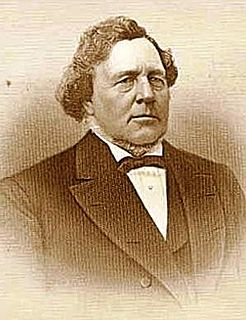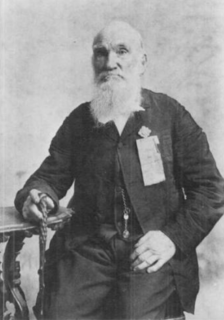
Iron County is a county in southwestern Utah, United States. As of the 2010 United States Census, the population was 46,163. Its county seat is Parowan, and the largest city is Cedar City.

Cedar City is the largest city in Iron County, Utah, United States. It is located 250 miles (400 km) south of Salt Lake City, and 170 miles (270 km) north of Las Vegas on Interstate 15. It is the home of Southern Utah University, the Utah Shakespeare Festival, the Utah Summer Games, the Simon Fest Theatre Co., and other events. As of the 2010 census the city had a population of 28,857, up from 20,257 in 2000. As of 2019 the estimated population was 34,764.

Parowan is a city in and the county seat of Iron County, Utah, United States. The population was 2,790 at the 2010 census, and in 2018 the estimated population was 3,100.

The Mormon Trail is the 1,300-mile (2,100 km) long route from Illinois to Utah that members of The Church of Jesus Christ of Latter-day Saints traveled for 3 months. Today, the Mormon Trail is a part of the United States National Trails System, known as the Mormon Pioneer National Historic Trail.

John Williams Gunnison was an American military officer and explorer.

George Albert Smith was an early leader in the Latter Day Saint movement. He served in the Quorum of the Twelve Apostles and as a member of the First Presidency of The Church of Jesus Christ of Latter-day Saints.
The Utah Parks Company, a subsidiary of Union Pacific Railroad, owned and operated restaurants, lodging, and bus tours in Bryce Canyon and Zion National Parks, the north rim of Grand Canyon National Park, and Cedar Breaks National Monument from the 1920s until 1972. Operating as a concessionaire of the National Park Service, the company operated from a base in Cedar City, Utah. The company's bus tours connected there with Union Pacific trains as well as tour buses from Los Angeles, San Francisco and other west coast cities, and offered a loop tour of the region's parks and monuments, escorted by a Utah Parks Company driver/guide.

Iron County School District is a school district in Cedar City, Utah.

Isaac Chauncey Haight, an early convert to the Latter Day Saint Movement, was a pioneer of the American West best remembered as a ringleader in the Mountain Meadows massacre. He was raised on a farm in New York, and became a Baptist at age 18, hoping to become a missionary in Burma. He educated himself, and found work as a schoolteacher. He converted to Mormonism and set out to convert others in his neighborhood, building up a branch with forty members. To escape religious persecution, his family arrived in Nauvoo, Illinois in July, 1842.
The conspiracy and siege of the Mountain Meadows Massacre was initially planned by its Mormon perpetrators to be a short "Indian" attack, against the Baker–Fancher party. But the planned attack was repulsed and soon turned into a siege, which later culminated in the massacre of the remaining emigrants, on September 11, 1857.

The following is an alphabetical list of articles related to the U.S. state of Utah.

Lund Highway is a road connecting Cedar City to the ghost town of Lund in Iron County, Utah. Although it is classified as a minor collector, it was once an important connection between the Union Pacific Railroad at Lund and the national parks of southern Utah and northern Arizona.

State Route 143 (SR-143) is a state highway in the U.S. state of Utah. The entire highway has been designated the Brian Head-Panguitch Lake Scenic Byway as part of the Utah Scenic Byways program. This road has also been designated as Utah's Patchwork Parkway as part of the National Forest Scenic Byway program.

Old Irontown, Old Iron Town, or Irontown, originally Iron City, is an unincorporated community and near-ghost town in Iron County, Utah, United States. It is located in Dixie National Forest, approximately 22 miles (35 km) from Cedar City. The settlement was founded in 1868 as a second attempt to mine iron from Iron Mountain after a disappointing yield from Cedar City. The colony lasted until 1876, when strife from the Edmunds–Tucker Act and the Panic of 1873 forced its closure. The site was added to the National Register of Historic Places in 1971.

The Parowan Meetinghouse, sometimes referred to as the Parowan Tabernacle or the Parowan Old Rock Church is a historic meetinghouse of The Church of Jesus Christ of Latter-day Saints in Parowan, Utah, United States, that is listed on the National Register of Historic Places (NRHP).

Priddy Meeks was an American frontier doctor who practiced Thomsonian medicine. He was a polygamist member of The Church of Jesus Christ of Latter-day Saints and helped settle areas in Utah as a Mormon pioneer. Meeks was the first doctor in Southern Utah. He occasionally appears as a character in Mormon literature, such as the short story "They Did Go Forth" by Maurine Whipple.

Benson Grist Mill is a restoration-replica museum located in Tooele County, Utah in the western United States, which allows visitors to see the inner workings of a latter-nineteenth-century pioneer gristmill. It has four other historic (nineteenth-century) buildings which have been moved onto the site, as well as four ancillary structures, including an open-air pavilion. It covers 6.98 acres along State Highway 138, 0.8 mile southwest of the intersection of the Road with State Highway 36. The museum is owned and operated by a division of Tooele County.

The Meeks-Green Farmstead in Parowan, Utah was listed on the National Register of Historic Places in 1994. The listing included four contributing buildings and one contributing structure.

John Steele was an Irish-American pioneer, local politician, physician, and astrologist. Born in Ireland, after converting to the Church of Jesus Christ of Latter-day Saints in Glasgow, Steele and his wife emigrated to Nauvoo, Illinois. Steele joined the Mormon Battalion and traveled to Salt Lake City with the Mormon pioneers. He was one of the founders of Parowan, Utah. Steele also contributed to the development of Iron, Kane, and Washington counties in Utah.


















